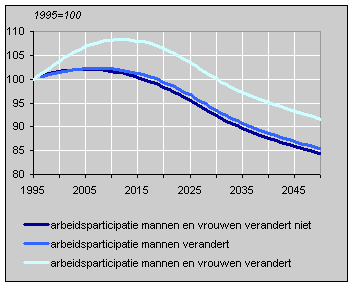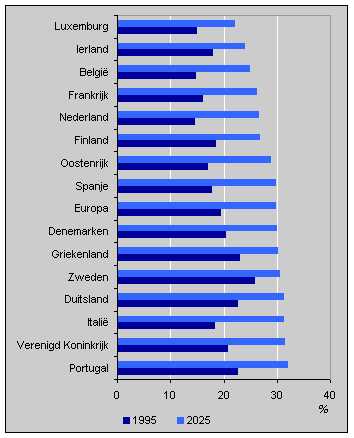European labour force expected to shrink

In the period 1985-1995 the labour force of the European Union (EU) increased from 154 to 169 million people. If the current demographic and labour participation trends continue, they present a scenario of a peak in the EU labour force somewhere around 2010, at 183 million people. After that the number will fall to around 155 million people in 2050.
Labour force in the European Union

Babyboomers nearing retirement
Although until now the labour force in the EU has increased continually, this will almost certainly not be the case in the future. After 2010, the post-war babyboom generation will reach retirement age, pushing down the size of the labour force. As many of these babyboomers will probably take early retirement , this decrease is expected to set in at about 2006, under the assumption that male and female labour participation rates remain the same.
Working longer
However, it now looks as if labour participation is increasing, a trend which would extend the period of growth of the labour force. Governments are introducing measures to stimulate the participation of older people in the labour force, making it easier for them to foot the public bill of social security and health care.
The labour participation of 55-64 year-olds is therefore expected to rise. The largest increases in participation among these older generations are foreseen in Italy, Spain, Austria and the Netherlands.
Share of 50-75 year-olds in the labour force

Furthermore, better opportunities for teenagers and young adults in the EU to combine study and work will result in more people in this age group having a paid job.
More women in paid employment
The increasing participation of women in the labour force will have a particularly noticeable effect on the development of the labour force in the EU, postponing the turnaround from an increasing to a decreasing labour force until around 2012.
The share of women in the EU labour force is expected to rise slightly from nearly 42% in 1995 to 44% in 2025. The largest increase will be in countries such as the Netherlands, Belgium and Austria. In the Netherlands it will rise from just over 41% to nearly 45%.
Traditionally, north European countries have the highest rates of women in the labour force. In Finland, for example, they account for 48% of employees.
Andries de Jong